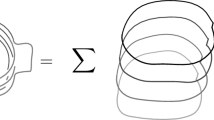Abstract
In this paper we study the optimal control of systems driven by nonlinear elliptic partial differential equations. First with the aid of an appropriate convexity hypothesis we establish the existence of optimal admissible pairs. Then we drop the convexity hypothesis and we pass to the larger relaxed system. First we consider a relaxed system based on the Gamkrelidze-Warga approach, in which the controls are transition probabilities. We show that this relaxed problem has always had a solution and the value of the problem is that of the original one. We also introduce two alternative formulations of the relaxed problem (one of them control free), which we show that they are both equivalent to the first one. Then we compare those relaxed problems, with that of Buttazzo which is based on the Γ-regularization of the “extended” cost functional. Finally using a powerful multiplier rule of Ioffe-Tichomirov, we derive necessary conditions for optimality in systems with inequality state constraints.
Similar content being viewed by others
References
N.U. Ahmed, Properties of relaxed trajectories for a class of nonlinear evolution equations on a Banach space. SIAM J. Control Optim.,21 (1983), 953–967.
N.U. Ahmed, Existence of optimal relaxed controls for differential inclusions on Banach space. Nonlinear Analysis and Applications (ed. V. Lakshmikantham), Proceedings of the 7th Intern. Conf. on Nonlinear Analysis and Applications, Lecture Notes in Pure and Appl. Math., Vol. 109, Marcel Dekker Inc., 19878, 39–49.
H. Attouch, Famille d’opérateurs maximaux monotones et mésurabilité. Ann. Mat. Pura Appl.,120 (1979), 35–111.
R. Aumann, Integrals of set valued functions. J. Math. Anal. Appl.,12 (1965), 1–12.
E. Balder, A general denseness result for relaxed control theory. Bull. Austr. Math. Soc.,30 (1984), 463–475.
E. Balder, Necessary and sufficient conditions forL 1-strong-weak lower semicontinuity of integral functionals. Nonlinear Anal.-T.M.A.,11 (1987), 1399–1404.
H. Berliocchi-J.M. Lasry, Intégrandes normales et mesures paramétrées en calcul des variations. Bull. Soc. Math. France,101 (1973), 129–184.
F. Browder, Pseudomonotone operators and nonlinear elliptic boundary value problems on unbounded domains. Proc. Nat. Acad. Sci. USA,74 (1977), 2659–2661.
G. Buttazzo, Some relaxation problems in optimal control theory. J. Math. Anal. Appl.,125 (1987), 272–287.
G. Buttazzo, Semicontinuity, Relaxation and Integral Representation in the Calculus of Variations. Longman Scientific and Technical, Vol. 207, New York, 1989.
G. Choquet, Lectures on Analysis, Vol. 1. Benjamin, New York, 1969.
C. Dellacherie and A. Meyer, Probabilities and Potential. North-Holland, Amsterdam, 1978.
N. Dunford and J. Schwartz, Linear Operators I. Wiley, New York, 1958.
I. Ekeland, Sur le contrôle optimal de systèmes gouvernés par des equations elliptiques. J. Functional Anal,9 (1972), 1–62.
R. Gamkrelidze, Principles of Optimal Control Theory. Plenum Press, New York, 1978.
M. Gebel, Control problem for equations of elliptic type. Cybernetics,4 (1974), 107–110.
F. Hiai and H. Umegaki, Integrals, conditional expectations and martingales of multivalued functions. J. Multivariate Anal.,7 (1977), 149–182.
A. Ioffe and V. Tichomirov, Theory of Extremal Problems. Elsevier, New York, 1979.
A. and C. Ionescu Tulcea, Topics in the Theory of Lifting. Springer, Berlin, 1969.
Yu. Kuznetsov, Necessary conditions for optimality in problems of control by systems described by elliptic equations. Siberian Math. J.,20 (1979), 410–417.
V. Levin, Borel sections of many valued maps. Siberian Math. J.,19 (1979), 434–438.
J.-L. Lions, Optimal Control of Systems Governed by Partial Differential Equations. Springer, New York, 1971.
R. Lucchetti, G. Salinetti and R. Wets, Uniform convergence of probability measures, topological criteria. Annals Statist., to appear.
E. Mascolo and L. Migliaccio, Relaxation methods in control theory. Appl. Math. Optim.,20 (1989), 97–103.
P. Michel, Necessary conditions for optimality of elliptic systems with positivity constraints on the state. SIAM J. Control Optim.,18 (1980), 91–97.
E. Nenakhov and V. Gorchakov, Necessary conditions of the extremum in optimal control problems for systems described by elliptic-type partial differential equations. Cybernetics,2 (1972), 262–267.
N.S. Papageorgiou, Convergence theorems for Banach space valued integrable multifunctions. Internat. J Math. Math. Sci.,10 (1987), 433–442.
N.S. Papageorgiou, Properties of the relaxed trajectories of evolution equations and optimal control. SIAM J. Control. Optim.,27 (1989), 267–288.
N.S. Papageorgiou, On the optimal control and relaxation of infinite dimensional control systems. Ann. Mat. Pura Appl.,165 (1989), 259–279.
N.S. Papageorgiou, Random fixed point theorems for measurable multifunctions in Banach spaces. Proc. Amer. Math. Soc.,97 (1986), 507–514.
R.T. Rockafellar, Convex Analysis. Princeton Univ. Press, Princeton, N.J., 1970.
M.-F. Saint Beuve, On the extension of Von Neumann-Aumann’s theorem. J. Funct. Anal.,17 (1974), 112–129.
V. Tichomirov, Theory of Extremal Problems. Wiley, New York, 1986.
J. Warga, Optimal Control of Differential and Functional Equations. Acad. Press, New York, 1972.
E. Zeidler, Nonlinear Functional Analysis and Applications II. Springer, Berlin, 1990.
T. Zolezzi, Necessary conditions for optimal control of elliptic or parabolic problems. SIAM J. Control Optim.,10 (1972), 594–607.
L. Cesari, Optimization: Theory and Applications. Springer, New York, 1983.
J.-L. Lions, Quelques Méthodes de Resolution des Problèmes aux Limites Non-Linéaires. Dunod, Paris, 1969.
Author information
Authors and Affiliations
Additional information
Revised version
Research supported by NSF Grant DMS-8802688
About this article
Cite this article
Papageorgiou, N.S. Optimal control and relaxation of nonlinear elliptic systems. Japan J. Indust. Appl. Math. 8, 525–550 (1991). https://doi.org/10.1007/BF03167150
Received:
Revised:
Issue Date:
DOI: https://doi.org/10.1007/BF03167150



